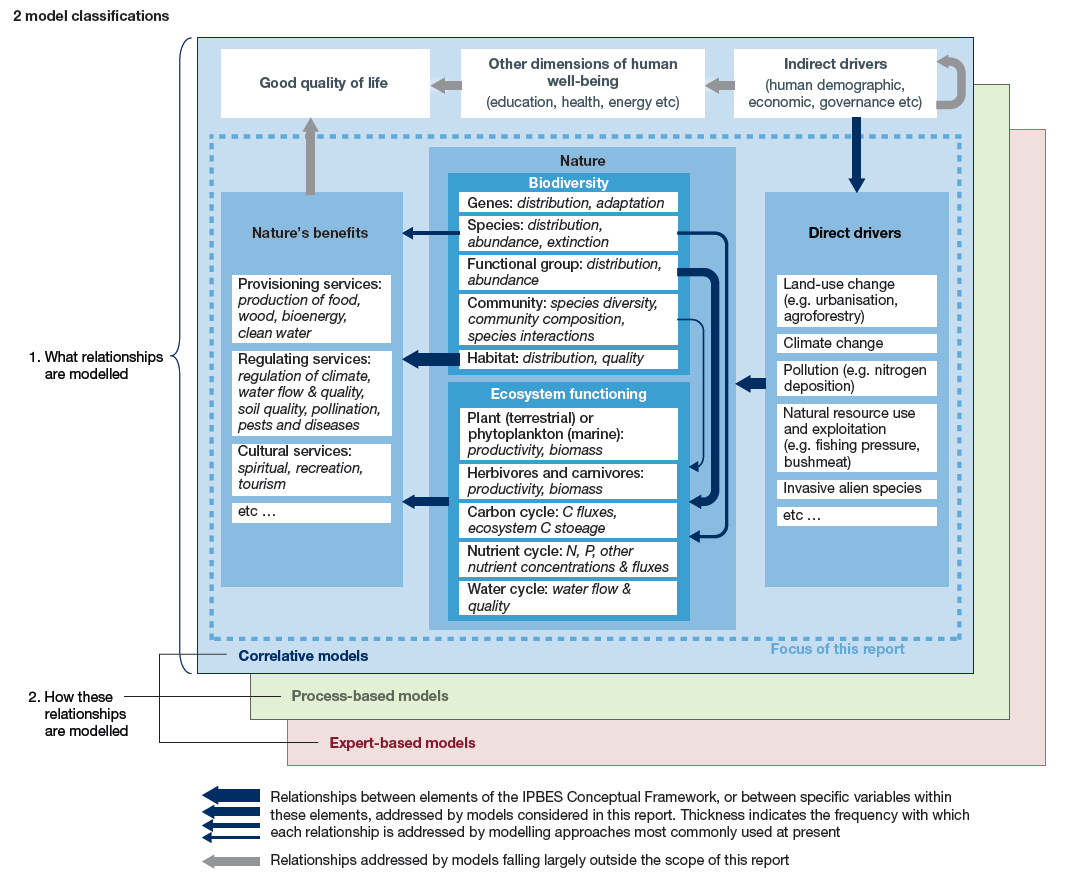Model Methodologies
‘Models’ are qualitative or quantitative descriptions of key components of a system and of relationships between those components. They are powerful tools for addressing complex systems as they can be used to assess and predict the impacts of drivers on biodiversity and ecosystems, and hence their impacts on ecosystem services and human well-being.
There is a diverse range of models which are relevant within the context of IPBES. These models vary in two main ways (See also Figure 1):
- What relationships are modelled – i.e. the outputs or ‘response variables’ of interest and the inputs used to predict or project these outputs;
- How these relationships are modelled – i.e. the way in which the link between input and output variables is represented.

Figure 1: Major types of models of relevance to IPBES activities, classified according to ‘what relationships are modelled’ (represented by the arrows linking elements of the IPBES Conceptual Framework, or variables within these elements) and ‘how these relationships are modelled’ (represented by the light-blue, green and pink-shaded panels). All of the relationships depicted on the light-blue-shaded ‘correlative models’ panel can also be modelled using ‘process-based models’ (green-shaded panel) or ‘expert-based models’ (pink-shaded panel).
What relationships are modelled?
The models considered in the IPBES methodological assessment on scenarios and models address three main types of relationship within the IPBES Conceptual Framework:
- Models addressing the effects of changes in indirect drivers (e.g. socio-political, economic, technological and cultural factors) on direct drivers of change in nature (e.g. land-use change, fishing pressure, climate change, invasive alien species, nitrogen deposition);
- Models addressing the impacts of changes in direct drivers on nature, including biodiversity and ecosystem functioning; and
- Models addressing the consequences of changes in nature for the benefits that people derive from nature, and that therefore contribute to good quality of life (human well-being) – including, but not limited to, ecosystem goods and services.
How these relationships are modelled?
The relationship between input and output variables can be represented or described by a model in many different ways, both quantitative and qualitative. Three broad approaches to modelling relationships between input and output variables are recognized in the IPBES methodological assessment on scenarios and models:
- Correlative models, in which available empirical data are used to estimate values for parameters that do not have a predefined ecological meaning, and for which processes are implicit rather than explicit;
- Process-based models, in which relationships are described in terms of explicitly-stated processes or mechanisms based on established scientific understanding and model parameters therefore have a clear, predefined, ecological interpretation;
- Expert-based models, in which the experience of experts and stakeholders, including local and indigenous knowledge holders, is used to describe relationships.